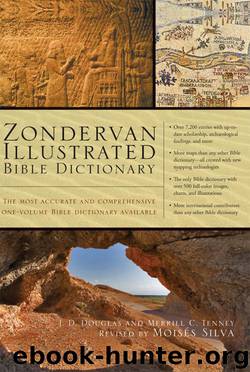Zondervan Illustrated Bible Dictionary by J. D. Douglas & Merrill C. Tenney & Moises Silva

Author:J. D. Douglas & Merrill C. Tenney & Moises Silva
Language: eng
Format: mobi
Tags: Religion, Biblical Reference, Dictionaries & Encyclopedias
ISBN: 0310229839
Publisher: Zondervan
Published: 2011-05-02T22:00:00+00:00
© Dr. James C. Martin
The battle between Gideon and the Midianites occurred here, in the Harod Valley. (View SE toward Mt. Gilboa.)
III. Appendix (Jdg. 17-21). The events recorded here seem to have occurred, not after the judges mentioned in the main part of the book, but during their judgeships. They are relegated to the appendix probably because they are narratives in their own right and if inserted in the main body would have marred the symmetry of the judge cycles there. These narratives describe life during this turbulent near-pagan period and give a frank and unvarnished description of the brutality and paganism that Israel was contaminated with because of her close association with her pagan Canaanite neighbors.
The LEVITE or Jdg. 17-18 was a priest who could follow his religious practice anywhere. He was hired as a family chaplain and soothsayer, and his presence was certain to bring “good luck” (17:13). He evidently functioned with idols (18:20) and was quite willing to change situations if the change involved a better salary (18:19-20). All of this is in direct contrast to the divine command concerning the priesthood in the Mosaic law.
The migration of the Danites (Jdg. 18) was necessitated by their failure to capture the territory assigned to them (Josh. 19:40-48; Jdg. 1:34-36). They then traveled to a northern valley, remote and defenseless, captured it, and settled there. Thus originated the northern DAN, known in the expression, “from Dan to Beersheba” (e.g., 1 Sam. 3:20; 2 Sam. 3:10; 1 Ki. 4:25).
The narrative of the Levite’s concubine (Jdg. 19) casts a livid light on the brutality of the times and introduces the war of the tribes against the Benjamites (chs. 20-21). This is not the only intertribal war of the period (8:1-3; 12:1-6). In fact, it is clear that the loyalty of the Hebrews at this time was a merely tribal one, as is the case with the bedouin until today. There was no real Hebrew nation; Israel was at best a very loose confederation of tribes around a central sanctuary, the TABERNACLE at SHILOH (18:31).
The cruelty and paganism of the narratives of Judges are often a stumbling block to readers. It should not be imagined that the writer is approving of everything he records. Rather, the book should be viewed as a history of the tragic judgment of God on a people who failed to keep their heritage of true religious faith by assimilating far too much of their surrounding culture. The history of the judges has been called “the struggle between faith and culture.” In this struggle, faith lost. And, of course, culture suffered also.
All this should not close our eyes to the beauty of the book of Judges as literature. Many of the narratives would rank high in any collection of the short stories of the world. Even in the most brutal passages there is an austere dignity. Sin is never reveled in; it is always held up to the gaze of horror. In the pungent discourse by JOTHAM (Jdg. 9:7-15), Judges has preserved almost the only fable in ancient Hebrew literature.
Download
This site does not store any files on its server. We only index and link to content provided by other sites. Please contact the content providers to delete copyright contents if any and email us, we'll remove relevant links or contents immediately.
The Five People You Meet in Heaven by Mitch Albom(3453)
Real Sex by Lauren F. Winner(2948)
Name Book, The: Over 10,000 Names--Their Meanings, Origins, and Spiritual Significance by Astoria Dorothy(2923)
The Secret Power of Speaking God's Word by Joyce Meyer(2906)
The Holy Spirit by Billy Graham(2868)
0041152001443424520 .pdf by Unknown(2757)
ESV Study Bible by Crossway(2722)
How The Mind Works by Steven Pinker(2710)
Ancient Worlds by Michael Scott(2605)
Churchill by Paul Johnson(2492)
The ESV Study Bible by Crossway Bibles(2485)
The Meaning of the Library by unknow(2484)
The Gnostic Gospels by Pagels Elaine(2454)
MOSES THE EGYPTIAN by Jan Assmann(2358)
Jesus by Paul Johnson(2290)
City of Stairs by Robert Jackson Bennett(2283)
The Complete Dead Sea Scrolls in English (7th Edition) (Penguin Classics) by Geza Vermes(2218)
Ancient Near Eastern Thought and the Old Testament by John H. Walton(2181)
The Nativity by Geza Vermes(2161)
